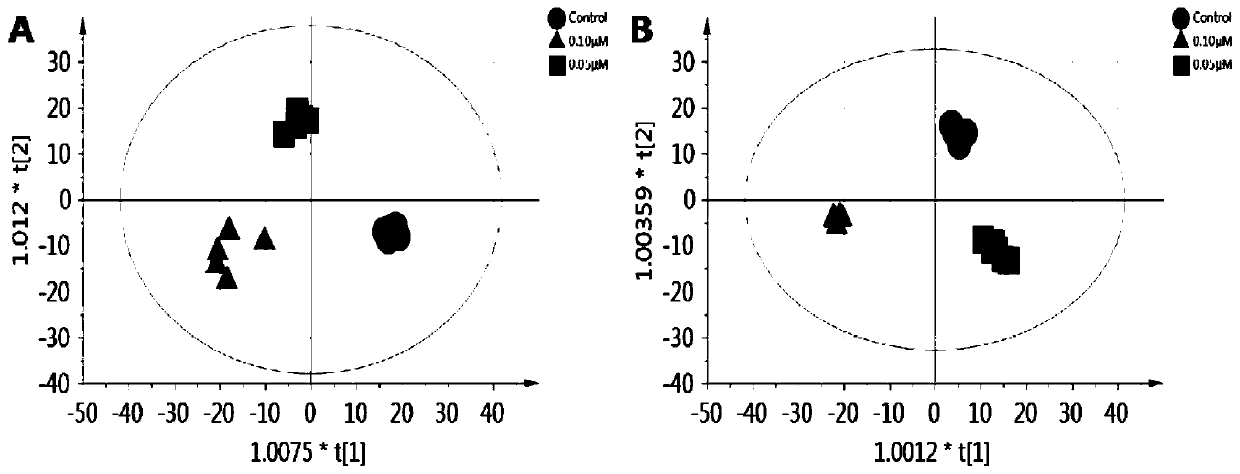A method for evaluating the early toxicity of trace exogenous chemicals using diagnostic markers and its application
A technology of diagnostic markers and chemicals, applied in the detection field, can solve the problems of environmental dose polluted water samples, abnormal zebrafish phenotype, and insufficient sensitivity, and achieve the effects of easy promotion and use, predictive significance, and high sensitivity
- Summary
- Abstract
- Description
- Claims
- Application Information
AI Technical Summary
Problems solved by technology
Method used
Image
Examples
Embodiment 1
[0045] The inventive method compares with conventional general toxicity method:
[0046] (1) Processing method of zebrafish general toxicity test samples
[0047] Collect normally developed zebrafish 2hpf fertilized eggs, put them in a 6-well plate, add 30 eggs to each well, and set 0, 0.01, 0.05, 0.1, 0.25, 1, 4, 10, 40, 100 μM concentration of cadmium chloride exposure group , and each concentration was parallelized 3 times. The microwell plate was placed in a constant temperature and light incubator at 28.5°C to 96hpf, observed every 24 hours, and the number of deaths was recorded.
[0048] (2) Metabolome experiment plus drug treatment
[0049] Take healthy 2hpf (hours after fertilization) zebrafish embryos, set up a blank group (normal sample) and 0.05, 0.1, 0.25μM cadmium chloride exposure groups, and continue to incubate in a 28.5°C incubator after administration.
[0050] (3) Metabolome sample processing
[0051] Collect larvae from each group at 96hpf, 50 zebrafish...
Embodiment 2
[0068] The method established by the present invention compares with the zebrafish behavior evaluation method:
[0069] (1) Using the behavioral prediction method on the zebrafish model:
[0070] Take the juvenile zebrafish with 2hpf development in a 6-well plate, about 15 per well, set up the control group and the 0.05, 0.10, 0.25, 0.50 and 1.00μM cadmium chloride exposure groups, and put them in an incubator at 28.5°C after administration Continue to incubate and perform 3 experimental operations in parallel. Replace the new exposure solution every day, and remove dead fish eggs or juveniles in time. At 96dpf, the juvenile fish were moved into the behavioral movement instrument, and after 5 minutes of adaptation, the spontaneous movement trajectory of the juvenile fish was recorded, and the uninterrupted video was recorded for 10 minutes, and the detection was performed 3 times in parallel.
[0071] (2) Adopt the prediction method of the present invention on the zebrafish ...
Embodiment 3
[0080] A method for predicting early toxicity of exogenous chemicals using a zebrafish model, evaluating the developmental toxicity of lead nitrate:
[0081] Lead nitrate solution to be tested, set 0.001, 0.006, 0.012μM lead nitrate dosage groups, add it to the petri dish, put it into the zebrafish embryo 6h after fertilization (hpf), set the blank group (normal sample) and the sample exposure group in parallel , each group of 50 embryos was put into an incubator at 28.5°C after the drug administration, and when it reached 120hpf, the larvae of each group were collected, placed in EP tubes with covers, washed with pure water three times, dried, and added with 800 μL of methanol-water mixed solution ( 4:1, -20℃), add steel balls, place in a tissue grinder and crush at 70Hz for 1min; place on ice for 30min; centrifuge at 14000rpm 4℃ for 10min, transfer the supernatant to a new centrifuge tube, and blow with nitrogen Blow dry on the instrument, add 200 μL methanol aqueous solutio...
PUM
 Login to View More
Login to View More Abstract
Description
Claims
Application Information
 Login to View More
Login to View More - R&D
- Intellectual Property
- Life Sciences
- Materials
- Tech Scout
- Unparalleled Data Quality
- Higher Quality Content
- 60% Fewer Hallucinations
Browse by: Latest US Patents, China's latest patents, Technical Efficacy Thesaurus, Application Domain, Technology Topic, Popular Technical Reports.
© 2025 PatSnap. All rights reserved.Legal|Privacy policy|Modern Slavery Act Transparency Statement|Sitemap|About US| Contact US: help@patsnap.com



